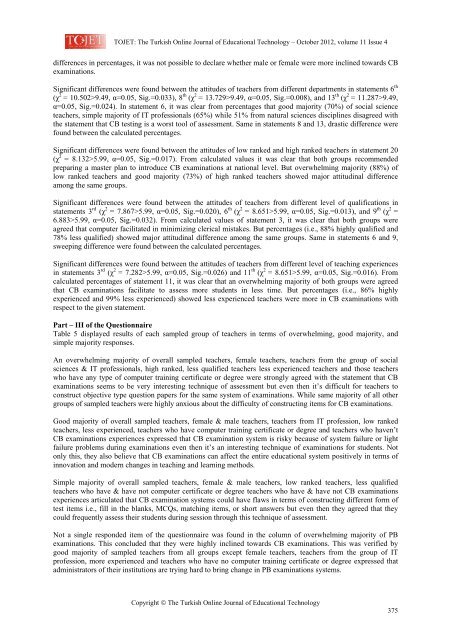october 2012 - TOJET the Turkish online journal of educational ...
october 2012 - TOJET the Turkish online journal of educational ...
october 2012 - TOJET the Turkish online journal of educational ...
You also want an ePaper? Increase the reach of your titles
YUMPU automatically turns print PDFs into web optimized ePapers that Google loves.
<strong>TOJET</strong>: The <strong>Turkish</strong> Online Journal <strong>of</strong> Educational Technology – October <strong>2012</strong>, volume 11 Issue 4<br />
differences in percentages, it was not possible to declare whe<strong>the</strong>r male or female were more inclined towards CB<br />
examinations.<br />
Significant differences were found between <strong>the</strong> attitudes <strong>of</strong> teachers from different departments in statements 6 th<br />
(χ 2 = 10.502>9.49, α=0.05, Sig.=0.033), 8 th (χ 2 = 13.729>9.49, α=0.05, Sig.=0.008), and 13 th (χ 2 = 11.287>9.49,<br />
α=0.05, Sig.=0.024). In statement 6, it was clear from percentages that good majority (70%) <strong>of</strong> social science<br />
teachers, simple majority <strong>of</strong> IT pr<strong>of</strong>essionals (65%) while 51% from natural sciences disciplines disagreed with<br />
<strong>the</strong> statement that CB testing is a worst tool <strong>of</strong> assessment. Same in statements 8 and 13, drastic difference were<br />
found between <strong>the</strong> calculated percentages.<br />
Significant differences were found between <strong>the</strong> attitudes <strong>of</strong> low ranked and high ranked teachers in statement 20<br />
(χ 2 = 8.132>5.99, α=0.05, Sig.=0.017). From calculated values it was clear that both groups recommended<br />
preparing a master plan to introduce CB examinations at national level. But overwhelming majority (88%) <strong>of</strong><br />
low ranked teachers and good majority (73%) <strong>of</strong> high ranked teachers showed major attitudinal difference<br />
among <strong>the</strong> same groups.<br />
Significant differences were found between <strong>the</strong> attitudes <strong>of</strong> teachers from different level <strong>of</strong> qualifications in<br />
statements 3 rd (χ 2 = 7.867>5.99, α=0.05, Sig.=0.020), 6 th (χ 2 = 8.651>5.99, α=0.05, Sig.=0.013), and 9 th (χ 2 =<br />
6.883>5.99, α=0.05, Sig.=0.032). From calculated values <strong>of</strong> statement 3, it was clear that both groups were<br />
agreed that computer facilitated in minimizing clerical mistakes. But percentages (i.e., 88% highly qualified and<br />
78% less qualified) showed major attitudinal difference among <strong>the</strong> same groups. Same in statements 6 and 9,<br />
sweeping difference were found between <strong>the</strong> calculated percentages.<br />
Significant differences were found between <strong>the</strong> attitudes <strong>of</strong> teachers from different level <strong>of</strong> teaching experiences<br />
in statements 3 rd (χ 2 = 7.282>5.99, α=0.05, Sig.=0.026) and 11 th (χ 2 = 8.651>5.99, α=0.05, Sig.=0.016). From<br />
calculated percentages <strong>of</strong> statement 11, it was clear that an overwhelming majority <strong>of</strong> both groups were agreed<br />
that CB examinations facilitate to assess more students in less time. But percentages (i.e., 86% highly<br />
experienced and 99% less experienced) showed less experienced teachers were more in CB examinations with<br />
respect to <strong>the</strong> given statement.<br />
Part – III <strong>of</strong> <strong>the</strong> Questionnaire<br />
Table 5 displayed results <strong>of</strong> each sampled group <strong>of</strong> teachers in terms <strong>of</strong> overwhelming, good majority, and<br />
simple majority responses.<br />
An overwhelming majority <strong>of</strong> overall sampled teachers, female teachers, teachers from <strong>the</strong> group <strong>of</strong> social<br />
sciences & IT pr<strong>of</strong>essionals, high ranked, less qualified teachers less experienced teachers and those teachers<br />
who have any type <strong>of</strong> computer training certificate or degree were strongly agreed with <strong>the</strong> statement that CB<br />
examinations seems to be very interesting technique <strong>of</strong> assessment but even <strong>the</strong>n it’s difficult for teachers to<br />
construct objective type question papers for <strong>the</strong> same system <strong>of</strong> examinations. While same majority <strong>of</strong> all o<strong>the</strong>r<br />
groups <strong>of</strong> sampled teachers were highly anxious about <strong>the</strong> difficulty <strong>of</strong> constructing items for CB examinations.<br />
Good majority <strong>of</strong> overall sampled teachers, female & male teachers, teachers from IT pr<strong>of</strong>ession, low ranked<br />
teachers, less experienced, teachers who have computer training certificate or degree and teachers who haven’t<br />
CB examinations experiences expressed that CB examination system is risky because <strong>of</strong> system failure or light<br />
failure problems during examinations even <strong>the</strong>n it’s an interesting technique <strong>of</strong> examinations for students. Not<br />
only this, <strong>the</strong>y also believe that CB examinations can affect <strong>the</strong> entire <strong>educational</strong> system positively in terms <strong>of</strong><br />
innovation and modern changes in teaching and learning methods.<br />
Simple majority <strong>of</strong> overall sampled teachers, female & male teachers, low ranked teachers, less qualified<br />
teachers who have & have not computer certificate or degree teachers who have & have not CB examinations<br />
experiences articulated that CB examination systems could have flaws in terms <strong>of</strong> constructing different form <strong>of</strong><br />
test items i.e., fill in <strong>the</strong> blanks, MCQs, matching items, or short answers but even <strong>the</strong>n <strong>the</strong>y agreed that <strong>the</strong>y<br />
could frequently assess <strong>the</strong>ir students during session through this technique <strong>of</strong> assessment.<br />
Not a single responded item <strong>of</strong> <strong>the</strong> questionnaire was found in <strong>the</strong> column <strong>of</strong> overwhelming majority <strong>of</strong> PB<br />
examinations. This concluded that <strong>the</strong>y were highly inclined towards CB examinations. This was verified by<br />
good majority <strong>of</strong> sampled teachers from all groups except female teachers, teachers from <strong>the</strong> group <strong>of</strong> IT<br />
pr<strong>of</strong>ession, more experienced and teachers who have no computer training certificate or degree expressed that<br />
administrators <strong>of</strong> <strong>the</strong>ir institutions are trying hard to bring change in PB examinations systems.<br />
Copyright © The <strong>Turkish</strong> Online Journal <strong>of</strong> Educational Technology<br />
375
















